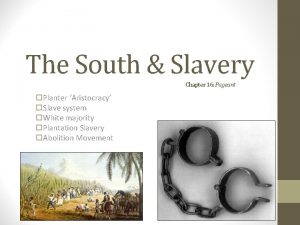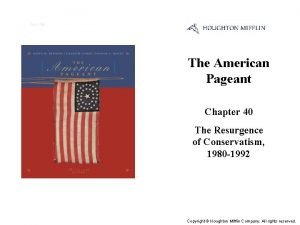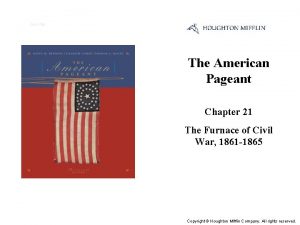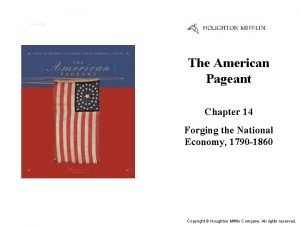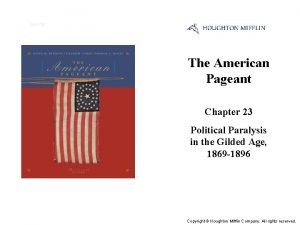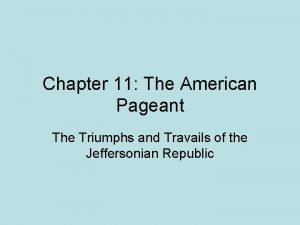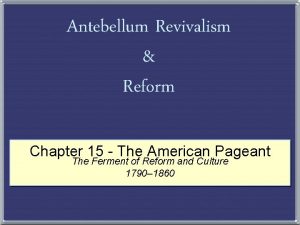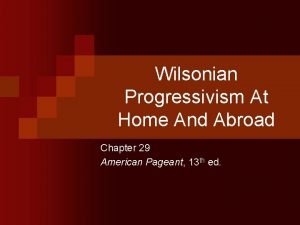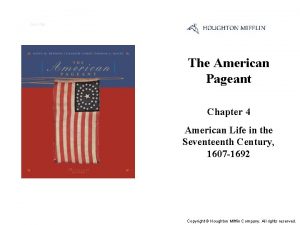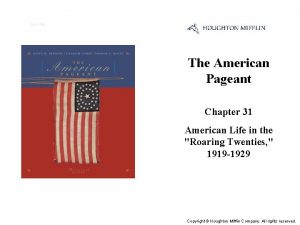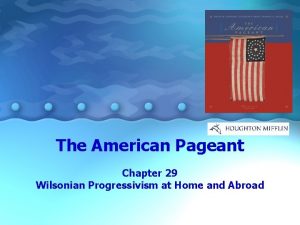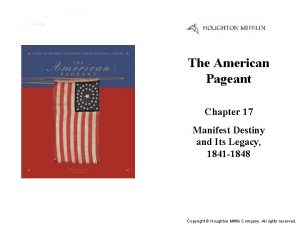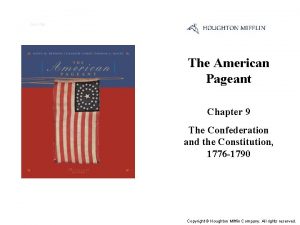The American Pageant Chapter 4 American Life in






















- Slides: 22

The American Pageant Chapter 4: American Life in the 17 th Century

Difficult life in the Chesapeake • Diseases such as malaria, dysentery, typhoid fever lead to 50% of the population in Virginia and Maryland not living past 20 • Six men for every woman in 1650. 3 men for every two women in 1700. • One parent usually dead in a family within 7 years • As native-born colonists gained immunities to diseases, the populations grew. In 1700, Virginia most populous and Maryland 3 rd.

Tobacco in Virginia and Maryland • As soil became unfertile, the colonists pushed inland for new land. • 1. 5 million pounds shipped out yearly in the 1630 s and nearly 40 million a year by 1700. • Increase in production lowers prices • Growing more requires more labor, and indentured servants where the key

Headright system • Whoever pays for a worker to come to Virginia or Maryland can get 50 acres of land • Benefits the WEALTHY • 100, 000 indentured servants brought to the Chesapeake area by 1700. • Huge estates created by wealthy planters • System leads to hard existence for many indentured servants even after they gain their freedom

Bacon’s Rebellion • Freemen in Virginia have a rough life in the late 1600 s. • In 1670, the Virginia assembly takes the vote away from most of these freemen who do not own land • Nearly 1, 000 Virginians rebel in 1676 led by Nathaniel Bacon

Reasons for Bacon’s Rebellion • Resented Governor William Berkeley’s friendly treatment of Native Americans • Berkeley refuses to retaliate against brutal attacks on frontier settlements • Bacon’s men killed hundreds of Native Americans, ran Berkeley out of Jamestown, and burned the city • The rebellion spread throughout Virginia • Ends when Bacon dies suddenly of disease, and Berkeley crushes the rebellion and hangs more than 20 rebels

Slavery in the Colonies • Increase in slavery directly tied to Bacon’s Rebellion and unrest of freemen • Less indentured servants coming from England • By the mid-1680 s, black slaves outnumber white servants in new arrivals to the southern colonies • Slave trade rises after 1700 as over 10, 000 Africans are brought to America by 1710

Map 4. 1: Main Sources of African Slaves, c. 1500– 1800 Copyright © by Houghton Mifflin Company. All rights reserved. 8

Treatment of Slaves • The “Middle Passage” – The horrible trip on a ship from Africa to the New World auction blocks in towns like Charleston and Newport, Rhode Island. – Death rates as high as 20% • Laws change based on race – Virginia (1662)- earliest slave codes make blacks and their children chattel – Crime in some colonies to teach slaves to read or write – Slavery begins for economic reasons, but racial discrimination will mold the slave system in America

Impact of Africans in America • Life for slaves hardest in the South on isolated rice plantations in South Carolina • Somewhat better conditions in Virginia – Farms closer together, more contact with family and friends, more women by the 1720 s so families are possible – Chesapeake slave society is one of the few slave societies in history to actually grow in number through reproduction

Impact of Africans in America • Language – Goober, gumbo, voodoo • Music – Banjo, bongo drum, later the development of jazz • Labor – Revolt in New York City and the Stono River Revolt in South Carolina examples of slaves trying to gain freedom, but none come close to the size of Bacon’s Rebellion. Slaves were a much more manageable labor force

Southern Society • Slavery leads to increased gap in society, most notably in disease and poverty • Small group of wealthy planters at the top – Owned lots of slaves, and held most of the political power – FFVs (First families of Virginia)- families that had been in Virginia since before 1690. Huge tracts of land controlled the House of Burgesses • Most were hard-working, and spent long hours managing their plantations

Southern Society • Small farmers – May own one or two slaves on small tracts of land – Subsistence farming for the most part • Landless whites – Mostly former indentured servants • Slaves • Few cities, so the urban professional class found in New England is slow to come about

Life in New England • Immigrants came as families typically, not as individuals • Women typically married by their early 20 s and on average had a child every two years • For women, child rearing was a full time occupation • Children grew up in stable environments where obedience was the rule • “Invention” of grandparents

Contrasts between Chesapeake and New England • Less rights for women in New England – Women give up property rights when married – “A true wife accounts subjection her honor” – Believed in Puritan society to be morally weaker than men • Not all bad for women – Widows could have property rights – Men were punished for abusing their wives – Integrity of marriage was defended as sacred • Little divorce, adultery one of the major reasons allowed

New England Towns • Close-knit society – Tied by geography – Puritan emphasis on unity of purpose • Orderly growth of society – New towns had to be legally chartered – Proprietors would get a land grant, move their families, and build a new town surrounding a meeting house and a town hall – Each family would get land for a woodlot, crops, and pasturing animals

New England Towns • Towns with more than 50 families required to provide elementary education • Harvard College founded in 1636 – Wasn’t until 1693 that William and Mary is established in Virginia • Town meetings are one “cradle of democracy”

Half-Way Covenant • Puritanism begins to be watered down by population spreading out • Half-Way Covenant admits to baptism, but not full communion, the children of the elect • Weakens the divide between the elect and others • Goal is to add more members to the church. • Women become the majority in Puritan congregations after this

Salem Witch Trials • Group of girls claim some older women had bewitched them • Leads to 19 hangings and 1 pressed to death • These persecutions were often targeting women that owned property • The accusers came from the farming families and the accused came from the new city economies in cities like Salem

New England Life • Soil and climate encourage a diversified agriculture and industry • Condemned the Native Americans for wasting the earth---justification for pushing them off the land • Goal was to improve the land • Introduction of livestock- pigs, horses, sheep, and cattle

New England Life • The large amounts of timber led to shipbuilding as a major industry • Fishing became a huge industry with the availability of cod off the coast

Wrapping Up • Women did the housework of cooking, cleaning, and watching children • Men planted and harvested crops, cut firewood, butchered livestock • Compared to most Europeans, the American colonists lived much better • Most whites that came to America were neither very wealthy nor very poor • Equality and democracy seem to be taking root…at least for the whites
 American pageant chapter 16
American pageant chapter 16 American pageant chapter 35
American pageant chapter 35 Chapter 40 american pageant
Chapter 40 american pageant American pageant chapter 21
American pageant chapter 21 Chapter 14 american pageant
Chapter 14 american pageant American pageant chapter 13
American pageant chapter 13 The american pageant chapter 30
The american pageant chapter 30 The american pageant chapter 23
The american pageant chapter 23 American pageant chapter 34
American pageant chapter 34 The american pageant chapter 5
The american pageant chapter 5 American pageant chapter 4
American pageant chapter 4 Chapter 9 american pageant
Chapter 9 american pageant American pageant chapter 11
American pageant chapter 11 American pageant chapter 15
American pageant chapter 15 American pageant chapter 41
American pageant chapter 41 Tampico incident definition
Tampico incident definition The best christmas pageant ever chapter 5
The best christmas pageant ever chapter 5 The best christmas pageant ever chapter 1
The best christmas pageant ever chapter 1 To kill a mockingbird study guide
To kill a mockingbird study guide The best christmas pageant ever novel study
The best christmas pageant ever novel study Medieval theater timeline
Medieval theater timeline Mansions medieval theatre
Mansions medieval theatre The best christmas pageant ever trailer
The best christmas pageant ever trailer
